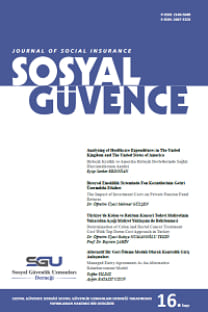HOW TO MINIMIZE OCCUPATIONAL ACCIDENTS IN TURKEY: THE BONUS-MALUS SYSTEM
Bu çalışma Türkiye'de meslek kazalarının azaltılması için Bonus-Malus Sistemi'ni (BMS) önermektedir. Kaza sayısına göre her bir basamak için özel bir prim oranına sahip 12 basamaklı bir yapı olan bu sistem, prim oranlarının işletmede meydana gelen kaza sayısına göre değişmesi gerektiği ilkesine dayanmaktadır. Tüm işletmeler 6. basamaktan %2 prim oranıyla sisteme giriş yapacaklardır. Her bir basamak için prim oranlarının hesaplanmasında beklenen değer ilkesi kullanılmaktadır. Markov zincirlerinin kullanılmasıyla yapılan analizde, sistem 45 yıllık bir zaman diliminde istikrarlı duruma erişmektedir. 5., 10., 20. ve 45. yıllarda işletmelerin kaza dağılımına göre Sosyal Sigortalar Kurumunun (SSK) prim gelirlerindeki değişiklikler araştırılmıştır. Sonuç olarak, zaman içerisinde bu sistem ile birlikte SSK'nın prim gelirlerinde düşüş olacağı ifade edilebilir. Buna karşılık, işletmelerin cezadan kaçma eğiliminde olacağı ve ödüle yönelerek meslek kazalarını önlemeye yönelik önlemleri artıracağı ve böylece kaza sayısının azalacağı tahmin edilmektedir.
TÜRKİYE'DE İŞ KAZALARININ AZALTILMASINA YÖNELİK BİR SİSTEM: BONUS-MALUS SİSTEMİ
This study suggests Bonus-Malus System (BMS) to minimize the occupational accidents in Turkey. Having a 12-class structure with a specific premium ratio for each class considering the number of accidents, the suggested system depends on the principle that the premium ratios should vary according to the number of accidents occurring in a given business. To enter the system, all businesses start from class 6, with a premium ratio of 2%. For the calculation of premium ratios for each class, the expected value principle is used. It is observed by using Markov chains that the system reaches the steady state in 45 years' time and the changes in the premium income of Social Security Institution (SSI) according to the distribution of businesses according to accident in the 5th, 10th, 20th, and 45th years are investigated. As a result, it is seen that the premium income of SSI will, in the course of time, decrease with BMS. In return, it is predicted that business are likely to try to escape punishment and turn to reward and increase measures against occupational accidents with a decrease in the number of accidents.
___
- Andreoni, D. (1986). The Cost of Occupational Accidents and Diseases. Gene- va: ILO.
- Miller, T. and Galbraith M. (1995). Estimating the costs of occupational injury in the United States. Accident Analysis and Prevention; 27 (6): 741-747.
- Head, L. and Harcourt, M. (1998). The direct and indirect costs of work injuries and diseases in New Zealand. Asia Pacific Journal of Human Resources; 36 (2): 46-58.
- Khanzode, V.V., Maiti, J. and Ray, P.K. (2012). Occupational injury and accidents research: a comprehensive review. Safety Science; 50: 1355-1367.
- ILO (International Labour Organization). (2014). Occupational injuries, Available from: http://www.ilo.org/ilostat [Accessed on 11 May, 2014].
- Ministry of Labor and Social Security. (2013). Labour Statistics, Available from: http://www.csgb.gov.tr/csgbPortal/ShowProperty/WLP%20Repository/csgb/ dosyalar/istatistikler/CalismaHayati-2013 [Accessed on 29 April, 2014]
- İşçi Sağlığı ve İş Güvenliği Meclisi. (2014). 2014 yılında en az 1886 işçi yaşamını yitirdi.Available from: http://www.guvenlicalisma.org/icerik/haber/dosyalar/2014. pdf [Accessed on 13 July, 2014]
- Hürriyet. (2014). Kusur varsa ceza büyük. Available from: http://www.hurriyet. com.tr/ekonomi/27238613.asp [Accessed on 20 September, 2014]
- Taraf. (2014). Kazasız iş yerine ödül, kazaya ağırlaştırılmış ceza geliyor. Available from: http://www.taraf.com.tr/haber-kazasiz-is-yerine-odul-kazaya-agirlastirilmis- ceza-geliyor-163636 [Accessed on 12 September, 2014]
- YeniŞafak. (2014). İş güvenliğinde ödül ve ceza devri. Available from: http:// www.yenisafak.com.tr/ekonomi/is-guvenliginde-odul-ve-ceza-devri-684583 [Accessed on 13 September, 2014]
- Social Security System. (2014). Available from: http://www.sgk.gov.tr/wps/ portal/en/english/social_security_system [Accessed on 03 October, 2014].
- İş Sağlığı ve Güvenliği Kanunu 20.06.2012 tarih ve 6331 sayılı RESMİ GAZETE.
- Sosyal Sigortalar ve Genel Sağlık Sigortası Kanunu ve Bazı Kanunlarda Değişiklik Yapılmasına Dair Kanun 10.01.2013 tarih ve 6385 sayılı RESMİ GAZETE.
- Eurogip. (2004). Costs and Funding of Occupational Diseases in Europe. Paris: Eurogip.
- Lemaire, J. (1976). Driver versus company: optimal behavior of the policyholder. Scandinavian Actuarial Journal: 209-219.
- European Agency for Safety and Health at Work. (2010). Economic incentives to improve occupational safety and health: a review from the European perspective. Luxemburg.
- Song, L., He, X. and Li, C. (2011). Longitudinal relationship between economic development and occupational accidents in China. Accident Analysis and Prevention; 43: 82-86.
- Bernardo, J. M., Smith, A.F. (1994). Bayesian Theory. John Wiley and Sons, New York.
- Jewell W. S. (2004). Encyclopedia of Actuarial Science, Bayesian Statistics. John Willey and Sons, New York.
- McFadden, J.A. (1965). The mixed poisson process. Sankhya: The Indian Journal of Statistics, Series A (1961-2002); 27(1): 83-92.
- Klugman, S., H. Panjerand and G. Willmot. (1998). Loss Models: From Data to Decisions. John Wiley and Sons: 211-212.
- Bühlmann, H. and Gisler, A. (2005). A Course in Credibility Theory and Its Applications. Springer Verlag.
- Kass, R., Goovaerts, M., Dhaene, J. and Denuit, M. (2008). Modern Actuarial Risk Theory: Using R, Springer.
- Lemaire, J. (2000). Bonus-Malus Systems in Automobile Insurance. Kluwer Academic Publishers, London.
- Parmenter M. M. (1999). Theory of Interest and Life Contingencies, with Pension Applications third ed. Actex Publications, Winsted.
- Çınlar, E. (2013). Stochastic Processes, fourth ed. Dover Publications New York.
- Walhin, J.F. and Paris, J. (2001).The practical replacement of a bonus-malus system. Astin Bulletin; 31(2): 317-335.
- Ceylan, H., 2011. Türkiye'deki iş kazalarının genel görünümü ve gelişmiş ülkelerle kıyaslanması. International Journal of Engineering Research and Development; 3(2): 18-24.
- Yih-Long, C. (2003). WinQSB User Guide. John Wiley.
- ISSN: 2146-5649
- Yayın Aralığı: 2
- Başlangıç: 2011
- Yayıncı: Sosyal Güvenlik Uzmanları Derneği
